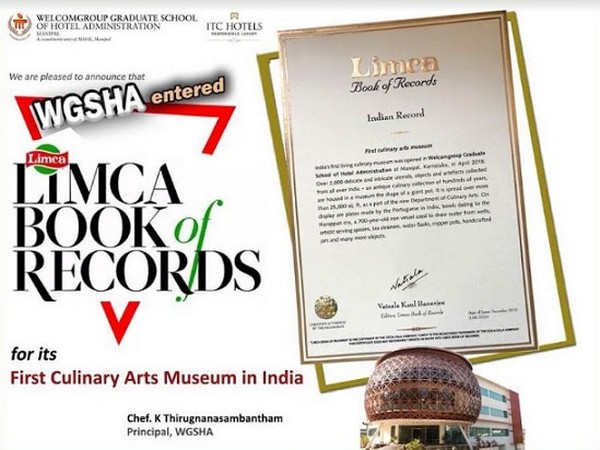MANIPAL, Karnataka: Team Welcomgroup Graduate School of Hotel Administration (WGSHA) of Manipal Academy of Higher Education (MAHE),is proud to announce the culinary museum in WGSHA has been listed in Limca Book of Records as India’s First Living Culinary Arts Museum. Limca Book of Records (LBR) is a catalogue of achievements made by Indians, at home and abroad in diverse fields of human endeavour.
Chef Thirugnanasambantham, Principal of WGSHA, while thanking MAHE and ITC Leadership for extending all support towards instituting this museum in Manipal and WGSHA, also appreciated all those who have directly or indirectly helped towards setting up this museum. Chef Thiru said,
The process for WGSHA’s culinary museum to make an entry into the popular Limca Book of Records started almost six months back and after validation by LBR recently, has been listed in the book of records. We are glad that we could be the first of its kind in such endeavor and we also hope to be in Guinness World Records soon.
On the background of having the museum, he said, We are indeed grateful to Michelin-starred Indian Celebrity Chef Vikas Khanna, the Founder and curator of this Museum, who had this idea of establishing a culinary museum and donated thousands of kitchen tools and equipment worth millions of dollars to this museum for preserving history of India’s rich tradition of culinary arts and to educate the future generations.
Chef Vikas Khanna, Distinguished Alumnus’ of WGSHA, being very desirous of making such a museum in India, what better place it would be than in his own Alma Mater!
Chef Thiru mentioned Udupi, popular for the famous Udupi Cuisine, and a temple town, is adjacent to International University Town of Manipal Academy of Higher Education (MAHE). MAHE is home to thousands of International students and visitors.
The great heritage of Udupi, combined with the large number of Indian and International students residing in an around Manipal, it was very apt for the college to create a museum for today’s youth and International visitors to understand the rich culinary heritage of India.
The culinary arts academic block housing the museum was opened in April, 2018, spread approximately over 25,000 sq. ft., and is shaped in the form of a giant pot very similar to the ones found in Harappa.
There are historical as well as regular household items such as plates made by the Portuguese in India, a 100-year-old ladle used to dole out food at temples and bowls dating to the Harappan era, an old seed sprinkler, an ancient Kashmiri tea brewer known as ‘samovar’, vessels from the Konkan, Udupi and Chettinad regions, apart from a large collection of rolling pins, utensils of all shapes and sizes, tea strainers of different types etc. NewsVoir







